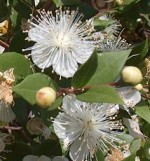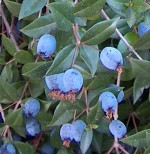 This upright evergreen shrub grown in the Mediterranean area since ancient times is especially popular in the coastal gardens of California and hot areas of Arizona. It is bushy, fine-textured, and has small lustrous bright green leaves that are aromatic when crushed. In late spring to early summer fragrant white to pinkish white flowers with numerous stamens are produced and followed by small blue-black edible berries. Although the flowers are not the main attraction of the shrub, they are a lovely delicate addition to the garden scene. Myrtle tolerates salt and some drought, thrives in heat but does not do well in humidity, drying winds, or wet soils. It takes well to shearing and can be pruned into formal hedges, topiary, and bonsai. Associated with love and peace, it is a popular foliage plant in wedding bouquets. Myrtle is a member of the Myrtaceae family that also includes clove and eucalyptus. The genus name, Myrtus, is from the Greek name for the plant, μύρτος (múrtos). The specific epithet, communis, is the classical Latin word meaning common and refers to the fact that this species is the most familiar.
This upright evergreen shrub grown in the Mediterranean area since ancient times is especially popular in the coastal gardens of California and hot areas of Arizona. It is bushy, fine-textured, and has small lustrous bright green leaves that are aromatic when crushed. In late spring to early summer fragrant white to pinkish white flowers with numerous stamens are produced and followed by small blue-black edible berries. Although the flowers are not the main attraction of the shrub, they are a lovely delicate addition to the garden scene. Myrtle tolerates salt and some drought, thrives in heat but does not do well in humidity, drying winds, or wet soils. It takes well to shearing and can be pruned into formal hedges, topiary, and bonsai. Associated with love and peace, it is a popular foliage plant in wedding bouquets. Myrtle is a member of the Myrtaceae family that also includes clove and eucalyptus. The genus name, Myrtus, is from the Greek name for the plant, μύρτος (múrtos). The specific epithet, communis, is the classical Latin word meaning common and refers to the fact that this species is the most familiar.
Type: Evergreen shrub
Outstanding Features: Fine textured-foliage
Form: Upright, bushy, oval
Growth Rate:Medium
Bloom: Small white to pinkish white flowers with numerous stamens in late spring to early summer followed by blue-black berries in late summer and fall
Size: 10′ H x 6′ W
Light: Full sun
Soil: Average, moist to medium dry, well-drained
Hardiness: Zones 9-11
Care: Prune to shape
Pests and Diseases: Generally pest and disease free but susceptible to scale followed by sooty mold; root rot in wet soil; thrips, spider mites
Propagation: Seed, semi-hardwood cuttings
Outstanding Selections:
‘Compacta’ (slow growing to 3′ tall)
Variegata’ (leaves with white margin)
Photo Credits Wikipedia